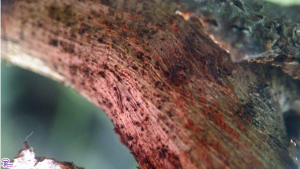#136: Inonotus obliquus, Chaga Mushroom
Chaga (produced by the fungus Inonotus obliquus) is considered by many to be the most potent medicinal mushroom. Its popularity is on the rise and a quick internet search returns mostly websites offering to sell Chaga or sites touting its medicinal benefits. Chaga purportedly has cancer-fighting properties, stimulates the immune system, reduces inflammation, and prevents aging. The part of the fungus that people use is not quite a mushroom. Instead, it is a sterile conk that looks like a large block of charcoal stuck to a birch tree. This structure can be chopped off the tree, ground up, and steeped in hot water to make a tea. Chaga tea is the usual way to take advantage of the fungus’s medicinal properties.







![#011: Characteristics of Kingdom Fungi [Archived]](https://www.fungusfactfriday.com/wp-content/themes/hueman/assets/front/img/thumb-small-empty.png)

